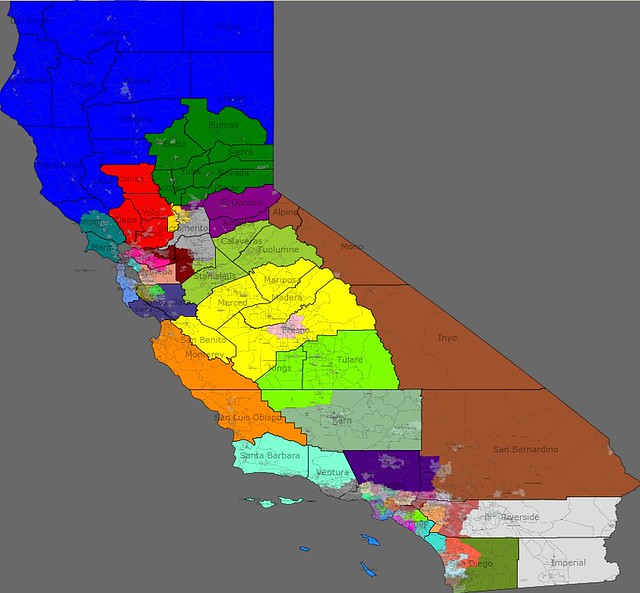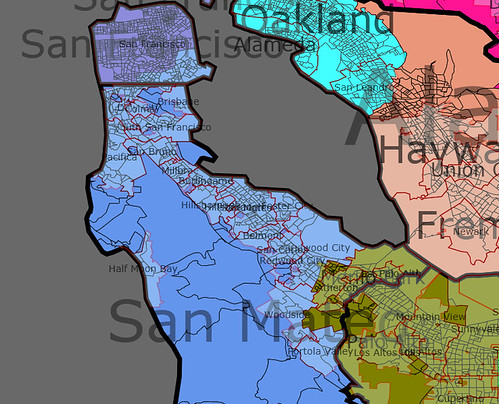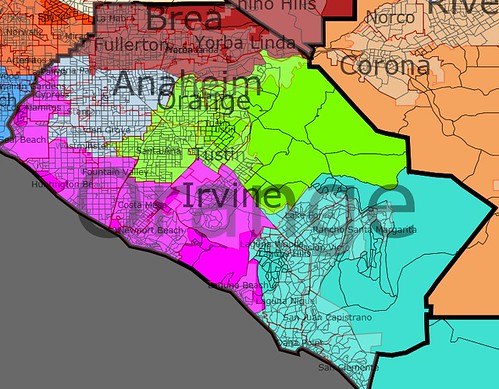In just a few days California voters will make final decisions on redistricting that will either expand the public commission process, or eliminate it entirely. These competing ballot measures, Prop 20 and 27 respectively both have intensely waged campaigns with big bucks from conservative backers taking on incumbent legislators and congressional members.
The latest polling has Proposition 20 passing and 27 losing. But what will that do for the state’s congressional delegation?
Using Dave’s Redistricting App I was able to draw these lines based on the criteria for the commission. These include geographic compactness, maintaining city and county lines, working to preserve communities of interest. What this avoids is looking at where incumbents live (the commission can’t know) or trying to draw lines based on any partisanship or competitiveness goal (the commission can draw no line to advantage or disadvantage a party).
Dave’s App is a bit dated in terms of its population estimates, so using current data the urban districts would likely expand a bit and rural districts would likely shrink. This is only an approximation and presents some of the challenges if a commission were to handle the redraw.
The numbering is not relevant and can really serve to confuse. Often times I will hear from a legislator or congressman “my district 18 is going to pick up this city” but under the commission both the numbering and the communities in a district will be determined by scratch. This fallacy diminishes the extraordinary impact of California’s decision to go to a lay board for political redistricting and give them the rules/restrictions that we have.
For the purposes of reviewing this plan I am describing districts by their core city or county, and where there are arbitrary numbers I may reference them, but it is a waste to get caught up into a discussion of why the 11th is in Southern California… that doesn’t matter.
Statewide Map
Population Shifts
The biggest factor in redrawing California (either through the legislature, commission or courts) is the uneven growth between rural and urban communities. Growth statewide for the past 10 years has been approximately 10%, with 5% growth in San Francisco, 3.5% growth in Los Angeles, and 35% growth in Riverside (inland southern California). That means urban districts expand as they reach to gobble up 1/53rd of the state’s population, while rural districts contract for the same reason.
Boxed In
Aside from the obvious borders with Oregon, Nevada, Arizona and Mexico, plus a huge ocean, there are also two mountain ranges that provide some relatively impenetrable boundaries for map drawers. In this map the central coast is drawn vertically because it doesn’t make sense to cross mountain ranges. The central valley is more “boxy” then the high desert is again vertical and long to take in population. San Francisco is in a way the easiest part to draw because map makers can start with an assumption that they will not cross a body of water and county/city lines in order to merge two communities (Marin and San Francisco) that do not share a lot of interests. So, the Bay Area map is first constrained by this factor, and population within the city pushes districts southward.
The Channel
One of the most interesting parts of the state is the Central Valley, specifically San Joaquin County. If mapmakers were to start in San Joaquin they could easily draw one congressional seat that would take it’s 687,000 residents. But this is not possible when looking at the whole state.
As the Bay Area gets drawn there are leftover residents in Alameda and Contra Costa Counties, and as the Northern districts are drawn there has to be an outlet for those excess residents. San Joaquin is perfectly located at the confluence of these two streams, and as overflow comes down the entire central valley acts as a channel for districts that need to expand to gain required population.
Neatness
Overall the new congressional map is going to look neater. Districts will take on odd shapes where that is the underlying geography or county / city lines, but where two cities or counties are combined they are adjacent. Based on the new rules line drawers are not going to purposefully capture one community by going around or past another closer similar community.
This map gets the state’s 53 districts into sets of approximately 690,000 with a variation of +/- 2%. Getting them perfect using projected 2009 data seemed an unnecessary headache. When the 2010 census information becomes available the lines will be redrawn in real GIS software using the new data.

Bay Area Map
The Bay area begins in San Francisco, both figuratively and in this case literally. Lines for the legislature and congress have crossed bodies of water, but under the commission rules it is extremely unlikely that they would draw a congressional district that crossed either the Bay Bridge or Golden Gate. The political geography starts at the top of San Franciso and counts south until you run out of residents. In this map I have favored geographic compactness, placing the south eastern portion of San Francisco into the San Mateo district. Without any emphasis on drawing districts that are neat or compact the better choice would be to draw the San Francisco district as a crescent, with the south-eastern part of the city becoming part of the seat to the south.
The San Mateo seat would take in 90% of San Mateo – and depending on the final census this district could grow to take more of San Mateo.
Also seen in this picture are the Northern Santa Clara seat to include a number of smaller cities like Cupertino, Mountain View, Los Altos and Sunnyvayle. This district goes up to the border of San Jose but should be able to avoid crossing that city line.
The map also gives a peek at the Alameda seats – one that neatly places Oakland, the city of Alameda and Albany into one district, and Hayward, Fremont and Union City into another. The casualties in Alameda County are San Leandro that is nearly impossible to keep whole, and Dublin and Livermore that have to be shipped into a Contra Costa district. Keeping Alameda County together is impossible and Contra Costa became a pass thru for Alameda’s excess population.

Los Angeles Map
Los Angeles is a tough part of the state to draw. There are long simmering changes in the core of the city where African Americans are being displaced by Latinos, conservative pockets of voters in the South Bay and San Gabriel Valley, extremely liberal white voters in Santa Monica, a strong LGBT population in West Hollywood, and a San Fernando Valley community that has sought to secede from the city.
In addition to the principles of geographic compactness, preservation of city lines and traditional communities of interest, I have also followed some of the flow of the city as I understand it from living there most my life. In the end I found that freeways were a significant geographic factor – which is appropriate or poetic for Los Angeles, the birthplace of freeway commuters. There is a district along the 210 freeway, another along the 10, one that follows the 405.
I tried to avoid totally dividing the San Fernando valley, with an interest in treating it almost as if it was a city itself. However, this had significant negative consequences in other parts of the County. I may try to address this with different lines when new data is available.
South Bay and South LA districts
The driving factor in drawing the South Bay is Long Beach. The city of LB plus a portion of LA that comes into the port, Wilmington, Harbor City and part of San Pedro makes a strong district with shared interests and neat following of city lines.
After drawing these lines there are several obvious districts to follow. North/northeast of Long Beach is a strong Latino district (61% Latino) with small cities, to the North/northwest are is a traditionally African American base of Compton, Carson, Inglewood (30% African American), then to the west is a good coastal district.
Santa Monica is a major LA area city and there are two options for drawing its congressional seat. Mapmakers could take it up to Malibu and Ventura county based on a coastal community of interest, or it can draw the district into LA and absorb the strongly LGBT city of West Hollywood. I chose the latter option.
Downtown LA districts
The LA city districts are shaped by the contours of the LA basin and some spillover population needs from the neighboring districts. Both are over 60% Latino and the southern one is just 2% white. Just to the east of downtown is a district that brings together several small cities, including the now world famous city of Bell. This district is 87% Latino.
San Fernando Valley districts
This map gives the San Fernando valley two congressional seats, one of which takes in the City of Burbank that is not technically part of LA city’s San Fernando Valley, but is often considered a “Valley” community. Under this plan the Valley suffers from encroachment on all sides. If the plan was started in the San Fernando Valley three congressional districts could be drawn, but that could be at the expense of other parts of the city.
San Gabriel Valley
The San Gabriel Valley is drawn horizontally, following the 210 freeway and foothills from Glendale to Pasadena and other smaller communities, then continues along the same plane to reach into San Bernardino. Below the foothills there are districts that follow the 10 freeway and 60.

Orange County districts
The conservative base of California, Orange County has in the last 20 years grown a strong Latino community of Democratic voters in and around Santa Ana and an adjoining conservative base of Vietnamese voters in and around Garden Grove.
The district begins in the south with the encroachment from Northern San Diego county. This puts Laguna Niguel and southern Orange County in with Oceanside, following the 5 and 405 freeways and the new toll highway 73.
The coastal district brings in Huntington and Newport beaches, and reaches up to Cypress in an attempt to go inland without dividing a major portion of the Vietnamese community.
Inland Orange County has one district where Vietnamese will be an influence community, and another where Latinos will have a strong voice. The Northern Orange County district bleeds out into San Bernardino and toward the Ontario airport.

I am happy to answer questions about any other parts of the state and discuss the challenges facing the commission if they are charged with drawing congressional lines. Doing a from-scratch new map provides them with a huge opportunity and challenge.
Please leave comments and I will monitor/respond.
 This coastal area has elected Republicans in the past, and it can be seen how in this map. Many of the higher income portions are either Republican leaning or narrowly Democratic. However the northern part of the district, including the city of LA portions makes this a safe Democratic seat.
This coastal area has elected Republicans in the past, and it can be seen how in this map. Many of the higher income portions are either Republican leaning or narrowly Democratic. However the northern part of the district, including the city of LA portions makes this a safe Democratic seat.  The Latino density is greatest inland and in the southern area where Hahn is most well known. Latinos could be a Hahn strength provided that these communities show up in a low-turnout election.
The Latino density is greatest inland and in the southern area where Hahn is most well known. Latinos could be a Hahn strength provided that these communities show up in a low-turnout election.  African American residents are more inland than CD 36, with only a small representation, mostly in the West Carson and LA portions of the district. Normally the African American vote would be a strong factor for Hahn as she and her father have strong support within that community. There has been some discussion that the district would have a larger African American base if the Commission made the coastal lines East/West rather than North/South. This would create two South Bay seats in which African Americans could be influential, however do so potentially at the expense of coastal communities of interest.
African American residents are more inland than CD 36, with only a small representation, mostly in the West Carson and LA portions of the district. Normally the African American vote would be a strong factor for Hahn as she and her father have strong support within that community. There has been some discussion that the district would have a larger African American base if the Commission made the coastal lines East/West rather than North/South. This would create two South Bay seats in which African Americans could be influential, however do so potentially at the expense of coastal communities of interest. Asian Voters could be a key voting bloc in this contest with the densest concentrations inside Torrance. Clearly this is a race where Ted Lieu would have been formidable, if he weren't in the middle of his own race for State Senate.
Asian Voters could be a key voting bloc in this contest with the densest concentrations inside Torrance. Clearly this is a race where Ted Lieu would have been formidable, if he weren't in the middle of his own race for State Senate.  Janice Hahn ran for Lieutenant Governor in June 2010, and this map shows where she won and lost, by precinct. A sitting councilmember with massive Name ID losing to a mayor from San Francisco in her LA backyard shows a major point of vulnerability.
Janice Hahn ran for Lieutenant Governor in June 2010, and this map shows where she won and lost, by precinct. A sitting councilmember with massive Name ID losing to a mayor from San Francisco in her LA backyard shows a major point of vulnerability. Marcy Winograd ran against Congresswoman Jane Harman in the June 2010 primary. Her campaign was primarily fueled by a progressive backlash to Harman who has been hawkish on middle east issues. As this map shows, a number of the most progressive precincts, particularly those up in the Venice area preferred her over Harman.
Marcy Winograd ran against Congresswoman Jane Harman in the June 2010 primary. Her campaign was primarily fueled by a progressive backlash to Harman who has been hawkish on middle east issues. As this map shows, a number of the most progressive precincts, particularly those up in the Venice area preferred her over Harman. The 2006 primary election for Secretary of State was a low-interest down ballot race with Ortiz performing strongly among Latinos. This can be seen in this map where the West Carson portion of the district is strongly supportive of Ortiz. However, Bowen wins the vast majority of the district, ultimately winning by a large margin.
The 2006 primary election for Secretary of State was a low-interest down ballot race with Ortiz performing strongly among Latinos. This can be seen in this map where the West Carson portion of the district is strongly supportive of Ortiz. However, Bowen wins the vast majority of the district, ultimately winning by a large margin. We know from the maps below that in the 2010 Democratic Primary for Lieutenant Governor Janice Hahn lost a chunk of precincts to San Francisco Mayor Gavin Newsom. But how does this relate to her performance in other parts of LA? As this map shows, Hahn won Congressional Districts 31-39. But of those CD 36 was her worst performance. In the districts mapped, Hahn beat Newsom by an average of 31 points, but in CD 36 she only beat him by 9 points. The heavy lift for the Hahn campaign will be confronting the fact that she is extremely popular in the city core, but had her worst election night performances along the coast.
We know from the maps below that in the 2010 Democratic Primary for Lieutenant Governor Janice Hahn lost a chunk of precincts to San Francisco Mayor Gavin Newsom. But how does this relate to her performance in other parts of LA? As this map shows, Hahn won Congressional Districts 31-39. But of those CD 36 was her worst performance. In the districts mapped, Hahn beat Newsom by an average of 31 points, but in CD 36 she only beat him by 9 points. The heavy lift for the Hahn campaign will be confronting the fact that she is extremely popular in the city core, but had her worst election night performances along the coast.  This compares the 2006 Bowen v. Ortiz race to the 2010 Hahn v. Newsom race, showing something local activists may already understand: Bowen is strongest in the most liberal and white portions of the district, while Hahn is strongest in the more urban LA and West Carson portions. This should be very concerning to Hahn as her base of support is also the lower registration and turnout part of the district.
This compares the 2006 Bowen v. Ortiz race to the 2010 Hahn v. Newsom race, showing something local activists may already understand: Bowen is strongest in the most liberal and white portions of the district, while Hahn is strongest in the more urban LA and West Carson portions. This should be very concerning to Hahn as her base of support is also the lower registration and turnout part of the district.


